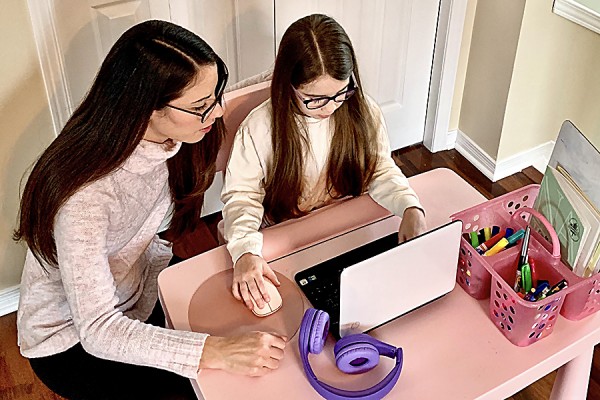 Kimberly Hillier, a teacher with the Windsor-Essex Catholic District School Board and instructor in the Faculty of Education, helps her daughter log on to classes in the morning before beginning her day of teaching online.
Kimberly Hillier, a teacher with the Windsor-Essex Catholic District School Board and instructor in the Faculty of Education, helps her daughter log on to classes in the morning before beginning her day of teaching online.
Looking back at the start of the pandemic, UWindsor’s Salsabel Almanssori marvels that she made it through each day.
A full-time teacher with the Greater Essex County District School Board, Almanssori was suddenly delivering lessons to her Grade 8 class online. Her husband was gone long hours as a small business owner, and with no extended family to rely on, it was up to Almanssori to care for their toddler during the day. In addition to her Grade 8 class, she was teaching a UWindsor course in Women’s and Gender Studies, and, as a doctoral candidate in UWindsor’s Faculty of Education, she had her dissertation proposal to prepare.
“It was challenging,” Almanssori said, in what can only be a great understatement.
Together with UWindsor’s Kimberly Hillier, Almanssori has written about how COVID-19 has affected the balance of her roles of mother, academic, and educator in an article in the Journal of the Motherhood Initiative.
The journal is a project of the Motherhood Initiative for Research and Community Involvement at York University. It publishes articles on motherhood across a multitude of perspectives including differences of class, race, sexuality, age, ethnicity, ability, and nationality. The latest edition focuses on the experiences of female academics during the pandemic.
“In our article, we use a feminist lens to look at the challenges associated with our multidimensional identities,” Almanssori said.
“We juxtapose our experiences at home with the expectations on us from the teaching front, from the academic front and from the home front where there are increases in domestic labour, caring for children, and homeschooling.”
Dr. Hillier is a primary teacher with the Windsor-Essex Catholic District School Board. She teaches while her six-year-old daughter is also learning online. Their school schedules begin and end 35 minutes apart and don’t share common lunch breaks or recesses.
Hillier, who got her PhD just as the pandemic was spreading to North America, also teaches an evening course in the Faculty of Education. It’s but another role she juggles.
Her own experiences have made her even more attuned to the needs of her students, many of whom are mothers of young children, too.
“As university instructors, we need to be empathetic and understanding of what’s going on in people’s personal lives right now.”
The same goes for employers, she said.
“Our experiences during the pandemic have stressed the importance of workplace flexibility and recognition of the demands that caregivers, especially mothers, are currently facing,” she said.
“The lion’s share of caregiving typically falls on the shoulders of mothers… With the pandemic, those demands have only increased.”
Hillier and Almanssori speak of the “emotional” labour women bear, too. Women are not only responsible for caring for their families, but organizing that care, too.
The responsibilities come with worry and guilt.
Almanssori had no choice but to put her son, Sajjad, now 2 years old, in daycare in September. She needs to focus on her students during the day and is expected to teach without distractions.
The thought of exposing Sajjad to the virus through his contact with other toddlers worries her. But she remembers the struggles of caring for her son and simultaneously teaching online at the end of the last school year. The added demands of the current school year would make it impossible for her to care for a toddler while teaching live most of the school day.
“He probably doesn’t remember what happened in March, but I still carry that guilt.”
Hillier and Almanssori said they hope their article draws greater attention to the issues of inequities in caregiving.
—Sarah Sacheli

UWindsor doctoral candidate Salsabel Almanssori says, as a full-time teacher with the Greater Essex County District School Board, she must balance life as a mother, an academic, and an educator. She said that even though she is working from home, she had no choice but to put her two-year-old son, Sajjad, in daycare.
